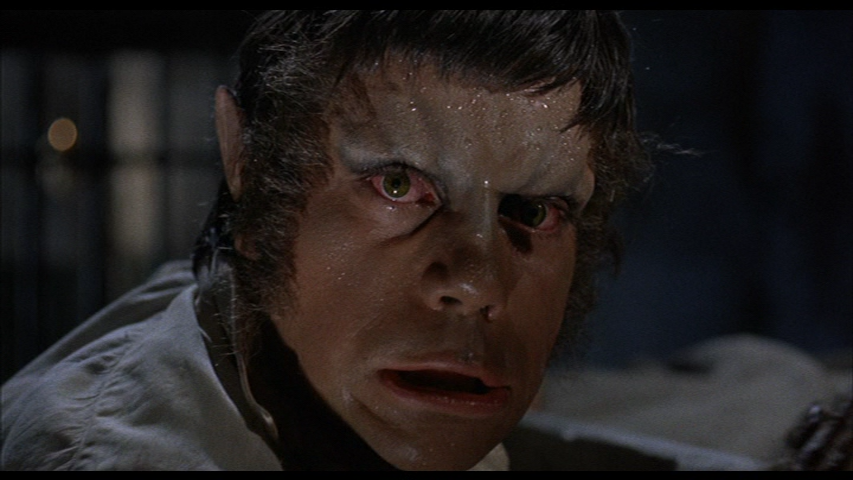The Curse of the Werewolf
Directed by Terence Fisher
Written by Anthony Hinds
UK, 1961
The original Universal Studios Wolf Man left an indelible mark on film history, particularly in it’s painstakingly specific make-up transformation that turned Lon Chaney, Jr.’s Larry Talbot into the title character. That effect has hung over every werewolf feature since, with films trying to compete with makeup maestro Jack Pierce’s legendary design. 20 years after the first Wolf Man film, Hammer Horror took a stab at the monster, utilizing a script based on A Werewolf in Paris and a barrel-chested Oliver Reed in his first film role.
By the time Hammer got around to making their werewolf film they’d already found success with multiple Peter Cushing/Christopher Lee vehicles such as The Mummy, Dracula and Frankenstein, all of which displayed exciting makeup effects, and they continued the trend early on in The Curse of the Werewolf. The story starts off with a beggar who is imprisoned by a merciless marques. The beggar is forgotten in a dungeon for 15 years, being cared for by a beautiful and mute jailer’s daughter. Time has not been good to the beggar; his face is worn and most of his body is covered in black tufts of hair. He’s a wild and homely creature at this point, his body taking on the characteristics of animal to mirror his inhuman treatment. The marques is also looking pretty rough; with his skin flaking off,he looks like a rotting phantom who doesn’t know he’s dead yet. These are merely appetizers meant to whet your appetite for the main course which doesn’t come until the final 10 minutes of the film.

For Oliver Reed’s transformation, Terence Fisher and makeup artist Roy Ashton opt to shoot Reed at different stages between regular guy and werewolf, letting the actor have brief moments within each stage to show the anguish in his metamorphosis. This is different than how Universal handled Chaney’s change, which was done in a lap dissolve which was created over the course of ten hours of shooting and applying makeup to yield only a few seconds of film. While this effect was quite magical it also required Lon Chaney remain still in the frame, his transformation seeming more like a wash over him. In Curse of the Werewolf, Oliver Reed rips at himself as his facial structure bulges and adjusts, and with this Fisher is able to milk the anticipation of the final reveal, creating fear with each change. Our first look at his face in the middle of his change is brief but no less frightening, – his bloodshot eyes under a grotesquely furrowed brow and his whole face is speckled in beads of sweat. Psychologically, this kills two birds with one stone as the audience can be both scared and sympathetic to Oliver Reed’s tragic character Leon, who is ultimately a victim of circumstance in all this.
The final werewolf makeup effect takes a slightly different approach from Jack Pierce’s classic design, most notably with less hair and prosthesis in the central area of the face, which not only brings out more of the humanity of the character, but gives Oliver Reed more use of his facial tools for acting purposes. This design also makes use of a faint widow’s peak which might be a nod to Jack Pierce who often made use of the devilish hairline for many of his creations. I actually prefer this type of look to the classic Wolf Man, and feel that Hammer certainly came through in this aspect of the film; however the picture as a whole isn’t as successful.
The first 20 minutes create a pretty riveting premise. Oliver Reed’s character is a product of a rape – his father being the beggar made feral by years of mistreatment and his mother was the mute jailer’s daughter, who was placed in the beggar’s cell for not placating the marques’ sexual advances. The beggar’s violation of the jailer’s daughter is seemingly his final act, as he is found dead shortly after – a morbid conception to be sure. The mute victim escapes and finds refuge with an upper-class family, who adopt her child when she dies during birth. The baby, Leon, was born on December 25th, and there are insinuations that he may be the anti-christ. This sets up perhaps the most nihilistic of Hammer Horror films, creating a character born from the bottom of society who can’t survive in the class system because oppressive forces operating that system have essentially shaped his future long before he was born. His affliction isn’t the result of magical curse, but because, in a way, his parent’s DNA was muted through subjugation and torture. The curse of the starving class.
While this sounds like the premise for a classic film with meaty subtext, it seems to lose the steam provided in that first act once Leon strikes out on his own and is caught up in a typical unrequited love story. While this type of plot could lend itself to what was already built up – particularly since the woman is the daughter of an upper-class vineyard owner and Leon’s boss. But instead it reads like a perfunctory distraction, meant merely provide more angst and anguish for Oliver Reed to brood on. It’s as though the film decided to play down to the expectations of its genre instead of rising above it. Even though those final 10 minutes are exciting bits of stunt work and action, and the film as a whole remains quite enjoyable even if on a superficial level, The Curse of the Werewolf still feels like the film squandered a golden opportunity to explore complex subject matter that would have turned it into an undeniable classic.


